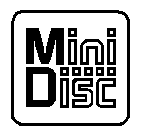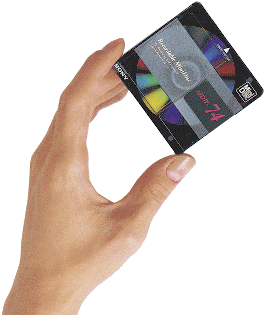[The MDCP circa January 1996, 7 weeks and several
kilobytes beyond its initial form]
 |
The MiniDisc Page
accesses to date.
|
 |
What are MiniDiscs?
MiniDiscs were introduced by Sony in 1992 as a new digital medium for
recording and distributing audio that is "near CD" in quality.
There are two types: Premastered
MDs, similar to CDs in operation and manufacture, and Recordable MDs,
which can be recorded on repeatedly and employ magneto-optical
technology. The disc itself is enclosed in a small (7cm x 7cm),
convenient, cartridge. |
Is there a MiniDisc mailing-list?
Yes, send mail to
[email protected] the message body should contain "subscribe md-l
<your name>". This mailing list has sporadic discussions of MD
related topics and is not particularly high traffic, on average. To
unsubscribe, send a mail message to
[email protected], the message body should contain "unsubscribe
md-l".
The
MiniDisc FAQ was last updated
18 Jan 1996
How do MiniDiscs work?
A single MD holds the same amount of music as a CD (74min) but does
so in one fifth as many bits by using an audio compression method Sony
calls ATRAC (Adaptive TRansform Acoustic Coding). ATRAC is a form of
perceptual coding, a data reduction technique that attempts to encode
only the information audible to the human perceptual system.
Perceptual coding, based
upon the masking
effect,
is also the principle behind the
Philips Digital
Compact Cassette PASC compression,
Dolby Labs AC-3 compression,
and
Bell Labs PAC (Perceptual Audio Coding) algorithm.
The
way data is actually stored on Recordable MDs is as follows
(taken directly from Sony MZ-R3 manual): "The laser inside the
recorder applies heat to the MD, demagnetizing the magnetic layer of
the MD. The recorder then applies a magnetic field to the layer.
This magnetic field corresponds exactly to the audio signals
generated by the connected source. (The north and south polarities
equate to digital "1" and "0".) The unmagnetized MD adopts the
polarity of the magnetic field, resulting in a recorded MD".
Sony describes the
Magneto-Optical (MO) recording technology used for MDs
in a technical paper on their HS MO system.
For a few hard numbers, check
Sony's MiniDisc Specifications.

A 1992 article from
Audio magazine gives a good general introduction to
the technology employed in MiniDisc.
Why should I get a MiniDisc recorder/player?
Sony intended the format as a replacement for the Compact Cassette.
It provides a relatively low cost solution to making high quality
recordings, and compared to Recordable CDs, it's smaller, cheaper and
re-writable. Compared to all forms of tape, it provides random
access, meaning that you can quickly select songs with the touch of a
button. Its primary competition, the Philips Digital
Compact Cassette (DCC), does not appear to have reached critical
mass, and it is not clear it ever will.
The only drawbacks to MD are the fact that you cannot make a perfect
digital copy of one (there is generational loss in every
decompress/compress cycle) and the relative high price of blank MDs
(US$10-$15 for a 74 minute disc). However, in Japan prices are as low
as $5 for a 60' blank and $6 for a 74' blank, and we can assume that
eventually prices will reach these levels worldwide.
An unabashed Minidisc fan argues
the MD case (vs. DAT) in this mail message.
Where can I get a MiniDisc recorder?
Most large appliance/electronics stores carry the recorders and blank
discs (e.g. Best Buy, Circuit City, Incredible Universe, Service
Merchandise, and most electronics specialty shops). Some music chains
like Tower Records and other large stores carry Prerecorded MDs,
however the prices do not seem to be much different than most other
CDs.
Who makes blank MiniDiscs and where can I buy them
cheaply?
There are multiple sources for the media: Sony, Kurare, TDK, Hitachi,
Maxell, Idemitsu, and Zeus. A recent price survey of blank MiniDiscs
gives MD US mail-order information.
What is available in Prerecorded MDs?
Here is
Sony's
Prerecorded Minidisc Catalog.
What MD products are available?
All major Japanese audio companies are now selling Minidisc products.
They are Sony, Sharp, Aiwa, Denon, Onkyo, Sansui, Sanyo, JVC,
Panasonic, Alpine, Clarion, Kenwood, Yamaha, and Pioneer.
Here is an incomplete MiniDisc equipment feature
table which includes the MD Data drives and the industrial units.
Within the table are links to further information.
Links related to MDs:
-
Sony,
innovators of the MiniDisc.
- Sony's
US Minidisc page.
- The
Pro Audio FAQ
is a good source of information about digital recording formats,
equipment, and theory.
- MD technology borrows heavily from CDs. This paper,
A Fundamental Introduction to the Compact Disc Player, provides
a good introduction to digital recording theory and practice.
Philips also has some excellent technical information about Audio CDs and Optical Disc
Technology.
- The
MPEG Audio Layer 3 FAQ, the
Usenet Compression FAQ's
Introduction to MPEG,
the
MPEG Information
Page
and these Audio
Compression References give further information about MPEG Audio
compression, one of the versions of which is actually the PASC system
used by Philips.
- The DAT Home
Page and the DAT-Heads
FAQ contain information pertinent to digital and live recording,
some of which applies to MiniDisc. In the FAQ there is a discussion of
the digital SCMS (serial copy management system) and its
circumvention.
- The
Music Connection
sells CDs as well as Mini Discs.
- Core Sound sells
binaural microphones, ideal for MiniDisc recording.
- A place called
POS makes CD copies of MDs for $25.
- The Home Recording Rights
Coalition works to preserve your rights to purchase and use
recording gear.
- Frank Beacham made a formal statement before
congress in 1992 lobbying against the Audio Home Recording Act.
- A
British MiniDisc page contains a few nice pictures, including a
diagram of how the "shock-resistant" memory system works.
- A paper discussing the additive
effects of audio compression algorithms explores concerns that
broadcasters have.
- This cross
reference table of commercial audio formats is quite useful.
Non-English MD Coverage
The Future
Aside from Sharp Corporation's
casual mention of a
700MB MD Data
drive they will have ready by 1997 (that's a 5X capacity increase) and
the interesting possibilities that may present for higher quality MD
audio, there is something of interest from NEC. It seems that just
when we thought MiniDiscs were the leading edge of portable audio
gear, NEC is showing a prototype of something it calls
Silicon Audio which uses a solid
state chip to store 24 minutes of MPEG Layer II compressed audio.
It's still a few years off though.
Feedback
Please address comments, updates, corrections, etc. to the page
maintainers:
Sumit Shah
[email protected]
and
Eric Woudenberg
[email protected]
This page maintained simultaneously on the
other side of the Pacific.
- First created on November 24, 1995
- Last updated on January 18, 1996



